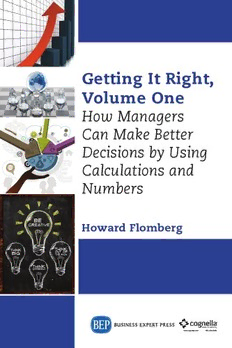Table Of ContentGetting It Right,
Volume One
How Managers
Can Make Better
Decisions by Using
Calculations and
Numbers
Howard Flomberg
Getting it Right,
Volume One
How Managers Can Make Better
Decisions by Using Calculations
and Numbers
Howard Flomberg
Getting it Right, Volume One
Copyright © Cognella Academic Publishing 2015
www.cognella.com
All rights reserved. No part of this publication may be reproduced,
stored in a retrieval system, or transmitted in any form or by any
means—electronic, mechanical, photocopy, recording, or any other
except for brief quotations, not to exceed 400 words, without the prior
permission of the publisher.
ISBN-13: 978-1-63157-202-9 (e-book)
Collection ISSN: 2163-9582 (electronic)
www.businessexpertpress.com
Trademark Notice: Product or corporate names may be trademarks
or registered trademarks, and are used only for identification and
explanation without intent to infringe.
A publication in the Business Expert Press Quantitative Approaches to
Decision Making collection.
Cover and interior design by S4Carlisle Publishing Services Private Ltd.,
Chennai, India.
Contents
Acknowledgements ................................................................................vii
Section 1 What’s To Come.............................................................1
Author’s Rules ...................................................................3
Introduction .....................................................................5
The Decision Model and Why It’s Important ....................9
What is Operations Research? .........................................11
Defining a Problem .........................................................12
Section 2 Using Numbers And Calculations
in Decision-Making ......................................................15
Essentials of Statistics and Probability .............................17
Examining Central Tendencies ........................................17
Defining the Mean and the Median ............................17
Defining the Standard Deviation ................................18
Statistics Are Not a Guarantee .........................................21
First Example: Stock Valuation ...................................21
Second Example: Company Salaries ...........................22
Third Example: Determining Percentages ...................23
Variables of Calculation and Estimation .....................24
Probability ......................................................................24
Bayes’ Rule and Conditional Probabilities .......................26
Bayes’ Theorem ...........................................................27
Using Tables ...............................................................28
What is Utility Theory? ...................................................30
Defining Risk Premium ..............................................31
Understanding Game Theory
by Examining Examples ...............................................33
Pascal’s Wager .............................................................34
The Prisoner’s Dilemma ..............................................35
Zero-Sum Games .......................................................36
The Nash Equilibrium ................................................37
iv CONTENTS
Dominant Strategies ...................................................39
Game Theory 1...........................................................41
Game Theory 2...........................................................42
More Games ...................................................................42
Evaluating Information ...................................................43
Is There Such a Thing as Perfect
Information (EVPI)? ...............................................43
What Is An Expected Opportunity
(EOL)? ....................................................................44
Hierarchical Analysis .......................................................46
Problem: Selecting a College to Attend .......................47
Making comparisons ..................................................48
Making Forecasts ............................................................50
Analyzing Trends ........................................................50
Working with Moving Averages ..................................52
Forecasting in the Real World .....................................52
Understanding Linear Programming ...............................53
Problem formulation ..................................................53
Graphical problem-solving .........................................55
Describing a Linear Regression ...................................57
Correlating Your Findings ...........................................63
Fuzzy Logic and Iterative Power ......................................64
Meeting in the Middle: Combining Numbers
with Observations (Can it Be Done?) ..........................65
Where Incompatibilities Lie .......................................65
Practical Ethics ................................................................67
John Stuart Mill and the Principle of Utility ...............67
Understanding Negative Utilitarianism .......................67
Understanding Preference Utilitarianism ....................68
Ethics and Decision-Making .......................................68
Ayn Rand and Objectivism .........................................68
What is the Judeo-Christian Viewpoint? .........................68
CONTENTS v
Section 3 Selecting and Using the Right Decision-Making
Tools for the Appropriate Situation ..............................71
Making the Final Decision ..............................................73
Managing Projects: an Overview .....................................77
A Construction Project: The Plan ...............................77
Factoring in the Human Element ...............................80
Index ...................................................................................................87
Acknowledgments
People who are mathematically inclined are frequently semi-literate.
With that in mind, I would like to thank my son, Dave Flomberg for his
support and encouragement, and for his assistance in turning my feeble
attempt at communication into acceptable English. Most of the editing
for the first edition was squeezed into his unbelievably tight schedule.
Thanks Dave!
We are all products of our education. I would like to include one of
my teachers and mentors Dr. Joe Megeath for giving me an invaluable
education on real values.
One of the ongoing lessons that I receive is that I frequently learn
more from my students than I realize. A paper turned in by a student,
Melanie Tyler, brought many of the points that I was trying to tie up
into focus. For that I thank her. This is yet another reminder that a good
teacher frequently learns from the student.
I’d also like to thank Brooke Pruter for her insightful feedback and
perspective.
This second edition has given me a chance to improve the book. I was
able to fix some arithmetic errors, tweak the text and add come content.
There is a new section Analytic Hierarchy. Some faculty from
other schools requested this tool. I am also putting many of the tables
into Excel© spreadsheets. The publisher will make these available to
instructors.
I’d like to thank the folks at University Readers. Their enthusiasm and
professional support made the project flow. I heartily recommend them
to other professors, especially those neophyte writers out there.
Ethical Pragmatism: “Doing what works best” while mindful of the obli-
gation one has to society.
Howard P. Flomberg
Denver, Colorado
SECTION 1
What’s to Come

